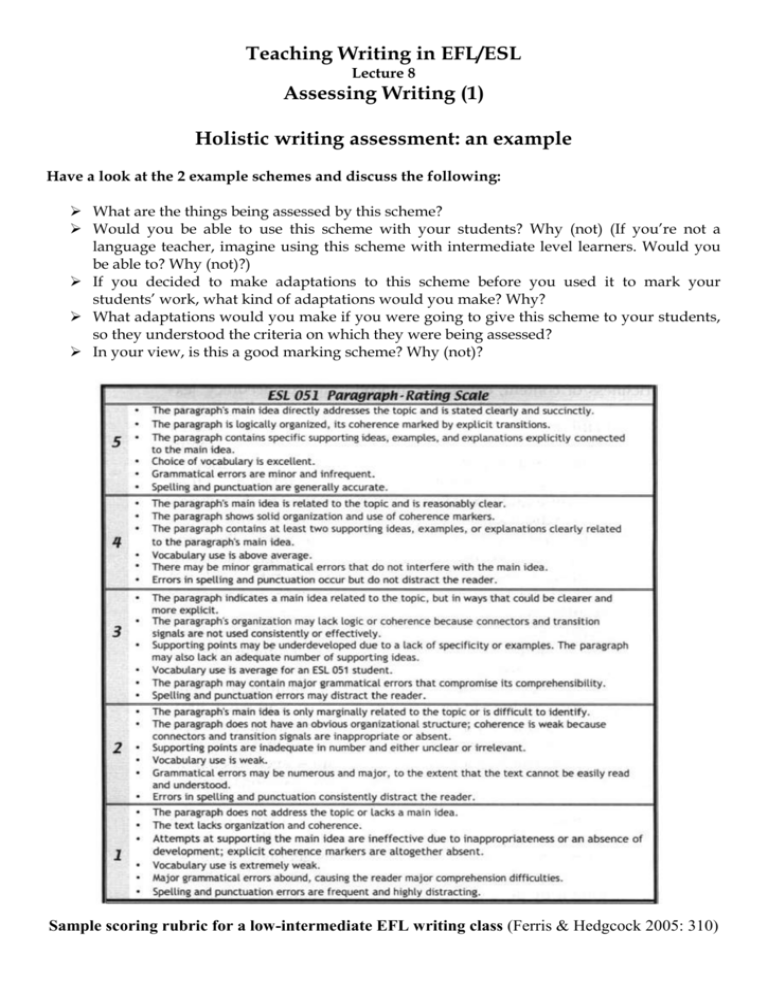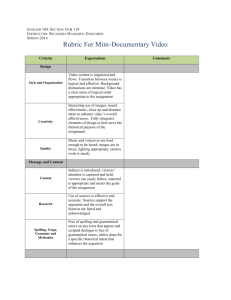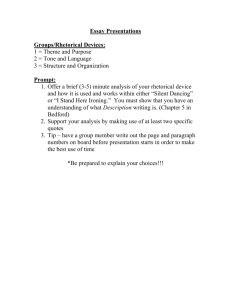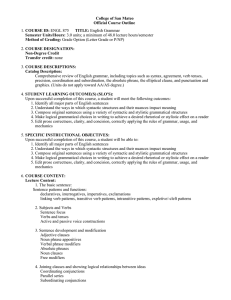Teaching Writing in EFL/ESL
advertisement

Teaching Writing in EFL/ESL Lecture 8 Assessing Writing (1) Holistic writing assessment: an example Have a look at the 2 example schemes and discuss the following: What are the things being assessed by this scheme? Would you be able to use this scheme with your students? Why (not) (If you’re not a language teacher, imagine using this scheme with intermediate level learners. Would you be able to? Why (not)?) If you decided to make adaptations to this scheme before you used it to mark your students’ work, what kind of adaptations would you make? Why? What adaptations would you make if you were going to give this scheme to your students, so they understood the criteria on which they were being assessed? In your view, is this a good marking scheme? Why (not)? Sample scoring rubric for a low-intermediate EFL writing class (Ferris & Hedgcock 2005: 310) Teaching Writing in EFL/ESL Lecture 8 Assessing Writing (1) Sample scoring rubric for an advanced-level social science EAP course (Ferris & Hedgcock 2005: 311) Characteristics of an ‘A’ paper An ‘A’ paper is admirably thorough and complete. Explicit and clear, the position is strongly and substantially argued with abundant reference to published works. The central issues and their complexity are treated seriously, with alternative viewpoints taken into account. The paper shows rhetorical control at the highest level and displays unity and subtle management. Ideas are balanced with support that is organized according to the content. Textual elements are connected through explicit logical and/or linguistic transitions. Repetition and redundancy are minimal. The paper shows excellent language control, accurate diction, stylistic precision, and meticulous adherence to the mechanical conventions. Characteristics of a ‘B’ paper A ‘B’ paper is thorough and complete. The text deals effectively with the issues, presenting the position clearly and articulating arguments substantively. References made to published works are ample and appropriate. Alternative perspectives are also addressed competently. The paper shows strong rhetorical control and is well managed. Ideas are generally balanced with support; the whole text shows strong control of organization that is appropriate to the content. Textual elements are generally well connected, although rhetorical fluency may at times need improvement. Occasional repetitions, redundancies and missing transitions may occur, but the paper reflects strong language control and reads smoothly. Grammatical well-formedness and accurate diction are apparent, although minor errors might be present. Stylistic and mechanical errors are minor and so not distract the reader. Characteristics of a ‘C’ paper Possibly lacking in thoroughness, a ‘C’ paper is nonetheless complete. The text discusses the issues but requires more focus, development and/or synthesis of published works. The position, while thoughtful, needs to be clarified; arguments may require further substantiation. Repetition, redundancy, and inconsistency sometimes compromise the paper’s focus and direction. Alternative viewpoints are minimally addressed and developed. Although the essay shows acceptable rhetorical control, competent management, and appropriate organization, ideas may not be balanced with support. The text shows evidence of planning, although a lack of connectors sometimes interferes with rhetorical fluency. Language is grammatical but may lack fluidity. Whereas the grammatical structures and lexical choices express the writer’s intended meanings, more appropriate choices could have been made. Morpho-syntactic, stylistic, and mechanical errors sometimes interfere with the reader’s comprehension. Papers assigned a mark of ‘C’ should be revised and resubmitted. Characteristics of a ‘D’ paper A ‘D’ paper lacks both completeness and thoroughness. Although the text may consider the issues, it relies heavily on opinions or claims that lack substantial evidence, sometimes leading the reader to wonder if the writer has come to grips with the complexity of the topic. Synthesis of published works is clearly deficient. Superficial and/or inconsistent argumentation, along with inadequate development, seriously compromise the text’s ability to convince the reader. Alternative perspectives are given little or no serious attention. Lacking rhetorical control much or most of the time, the paper’s overall shape is difficult to discern. The organization suggests a lack of balance and support that leads to noticeable breakdowns in rhetorical fluency. Transitions within and across sentences and paragraphs are attempted, with only partial success. Displaying weak linguistic control, the text contains grammatical, lexical, and mechanical errors that are a serious threat to the reader’s comprehension. Papers assigned a mark of ‘D’ must be revised and resubmitted. Characteristics of an ‘F’ paper An ‘F’ paper is unsuccessful because it is clearly incomplete and fails to develop and support an argument related to the topic. While the topic may be mentioned, the text digresses and/or does not treat issues of relevance to the assignment. Superficial and inaccurate treatment of published works suggests a failure to read sources carefully and extensively. Demonstrating little rhetorical control, the paper shows virtually no evidence of planning or organization, as exemplified in underdeveloped and/or nonexistent connections and transitions. The text demonstrates inadequate linguistic control, with morpho-syntactic, lexical, and mechanical errors seriously marring the writer’s intended meaning. Papers assigned a mark of ‘F’ must be revised and resubmitted.



![Program`s Dynamic Criteria Map (DCM)[1]](http://s3.studylib.net/store/data/007112770_1-0a2faad44b8e94d6ea99c5f4cbf00e83-300x300.png)






